The gorgeous Grecìa Salentina
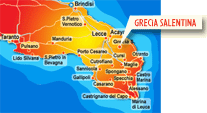 This area is formed by nine towns, where the traditions take us back to the past, to an ancient language (the “griko”, a sort of solemn Greek language) which is still today spoken by old people and which is seen at the entrance of each town, in the road signal reporting the words “kalos irtate”, that means “welcome”. We advise you to visit it at least in two days so that you can admire most places and hear the Greek language spoken at every corner of the streets. Moreover, if you have time, you can eat some specialities of Greek savour which are delicious. This area is formed by nine towns, where the traditions take us back to the past, to an ancient language (the “griko”, a sort of solemn Greek language) which is still today spoken by old people and which is seen at the entrance of each town, in the road signal reporting the words “kalos irtate”, that means “welcome”. We advise you to visit it at least in two days so that you can admire most places and hear the Greek language spoken at every corner of the streets. Moreover, if you have time, you can eat some specialities of Greek savour which are delicious.
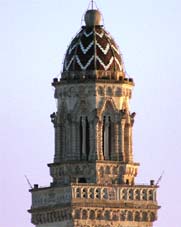 Soleto is the first town you meet, famous for the “Guglia of Raimondello”, the bell-tower of the Church dedicated to St. Maria Assunta built in 1397. The legend says that four devils built it all in a night. Anyway it is a wonderful bell-tower, 45 metres high, in late Gothic style that shows the wealth and the power of the Orsini del Balzo family, whose prestige made Soleto the most important town of Grecia Salentina. You can also visit the Chapel of Santo Stefano (1300), a pretty and small chapel, with its beautiful Romanic portal, the Gothic vaulted bell-tower and the façade in “pietra leccese”. The frescoes and the inscriptions on the walls are in Byzantine style as well as the “blessing Christ”, the fresco in the apse where four bishops hold an ornament containing prayers from Byzantine liturgy. Sacked by the Turks in 1480 after the siege of Otranto, Soleto still keeps a beautiful historical centre full of noble palaces dated 1400 and 1500 and built in Baroque style. Soleto is the first town you meet, famous for the “Guglia of Raimondello”, the bell-tower of the Church dedicated to St. Maria Assunta built in 1397. The legend says that four devils built it all in a night. Anyway it is a wonderful bell-tower, 45 metres high, in late Gothic style that shows the wealth and the power of the Orsini del Balzo family, whose prestige made Soleto the most important town of Grecia Salentina. You can also visit the Chapel of Santo Stefano (1300), a pretty and small chapel, with its beautiful Romanic portal, the Gothic vaulted bell-tower and the façade in “pietra leccese”. The frescoes and the inscriptions on the walls are in Byzantine style as well as the “blessing Christ”, the fresco in the apse where four bishops hold an ornament containing prayers from Byzantine liturgy. Sacked by the Turks in 1480 after the siege of Otranto, Soleto still keeps a beautiful historical centre full of noble palaces dated 1400 and 1500 and built in Baroque style.
The next town is Sternatia, a town of the 9th or 10th century a. D., a period which saw a strong immigration of monks and merchants from Greece and the Eastern world. In that period Sternatia 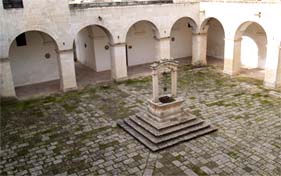 was under the Normans, then under the Orsini del Balzo and finally under the Granafei family, who held the feud until 19th century. Visitors are welcome by an old olive tree set in the middle of the square; it seems as if the tree keeps the secrets of the town, old images of farmers at work or of women in the fields. On the bell-tower of the “Church of the Assunta” there is an old clock, that strikes the passing of time in the crypts, in the oil-mills and in the narrow streets which, at lunch time, exhale smells of roasted peppers. Few steps away from the square there is “Palazzo Granafei”, a big fortress of the 18th century with a beautiful cloister. Sternatia is famous too for its underground oil mill, recently restored. You can go down and see how people made oil in the past. Beyond the 15th century walls there is the “Crypt of St. Sebastiano” (9th century), rich of frescoes representing the Holy Trinity. Do not forget to visit also the ex “Convent of the Dominicans”, now the seat of the Town Hall. was under the Normans, then under the Orsini del Balzo and finally under the Granafei family, who held the feud until 19th century. Visitors are welcome by an old olive tree set in the middle of the square; it seems as if the tree keeps the secrets of the town, old images of farmers at work or of women in the fields. On the bell-tower of the “Church of the Assunta” there is an old clock, that strikes the passing of time in the crypts, in the oil-mills and in the narrow streets which, at lunch time, exhale smells of roasted peppers. Few steps away from the square there is “Palazzo Granafei”, a big fortress of the 18th century with a beautiful cloister. Sternatia is famous too for its underground oil mill, recently restored. You can go down and see how people made oil in the past. Beyond the 15th century walls there is the “Crypt of St. Sebastiano” (9th century), rich of frescoes representing the Holy Trinity. Do not forget to visit also the ex “Convent of the Dominicans”, now the seat of the Town Hall.
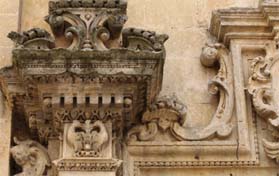 Few kilometres farther there is Calimera, that in Griko means “good morning”. The main church (Chiesa Madre) is in Piazza del Sole and is dedicated to St. Brizio; inside there are nice Baroque altars and beautiful paintings. In the square there is also a little chapel (The Chapel of the Crucifix) with a wooden polychrome crucifix in full-relief of the 16th - 17th century. It represents Christ just before his death. Not far from here, in the park, there is a little aedicule with a funeral stele of the 4th century B.C. It witnesses the link between Few kilometres farther there is Calimera, that in Griko means “good morning”. The main church (Chiesa Madre) is in Piazza del Sole and is dedicated to St. Brizio; inside there are nice Baroque altars and beautiful paintings. In the square there is also a little chapel (The Chapel of the Crucifix) with a wooden polychrome crucifix in full-relief of the 16th - 17th century. It represents Christ just before his death. Not far from here, in the park, there is a little aedicule with a funeral stele of the 4th century B.C. It witnesses the link between  Calimera and Greece, in fact this stele was discovered in Athen and given in 1960 “as a witness of the common origin”. Calimera is a town surrounded by religion, legends and rituals. For example, on the way to Martano there is the “Chapel of San Vito”; here, every year on Easter Monday, an ancient and magic ritual takes place, which is propitiatory of wealth and productiveness. In the chapel, in fact, there is a magic stone called “la petra de Santu Vitu” (the stone of St. Vito), dating back to prehistorical age; it has a hole in the middle and everybody magically is able to pass through it. This act is considered propitiatory of good crops. Calimera and Greece, in fact this stele was discovered in Athen and given in 1960 “as a witness of the common origin”. Calimera is a town surrounded by religion, legends and rituals. For example, on the way to Martano there is the “Chapel of San Vito”; here, every year on Easter Monday, an ancient and magic ritual takes place, which is propitiatory of wealth and productiveness. In the chapel, in fact, there is a magic stone called “la petra de Santu Vitu” (the stone of St. Vito), dating back to prehistorical age; it has a hole in the middle and everybody magically is able to pass through it. This act is considered propitiatory of good crops.
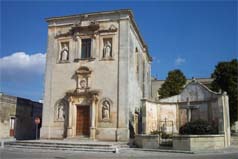 In the hearth of Grecia Salentina is Zollino. Here there are not many historical memories. Perhaps it was founded by people from Soleto, in fact its coat of arms bears a Sun, the same as in that of Soleteo. The town felt a strong Byzantine influence but the Greek rite disappeared in 1688. There is the “Church dedicated to Ss. Pietro and Paolo” and, in the main square, the 18th century column. In Zollino people celebrate St. Antonio who, in the past, protected the town during some natural disasters: earthquakes and floods. In the hearth of Grecia Salentina is Zollino. Here there are not many historical memories. Perhaps it was founded by people from Soleto, in fact its coat of arms bears a Sun, the same as in that of Soleteo. The town felt a strong Byzantine influence but the Greek rite disappeared in 1688. There is the “Church dedicated to Ss. Pietro and Paolo” and, in the main square, the 18th century column. In Zollino people celebrate St. Antonio who, in the past, protected the town during some natural disasters: earthquakes and floods.
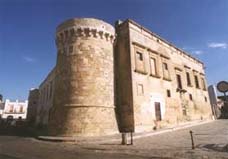 Martano was probably founded by the Roman centurion Martius, as we elicit from the coat of arms. After the decay of the Roman Empire, Martano was under the Greek domination and from the Greeks they inherited uses and habits. There is a beautiful Aragonese Castle (15th century) which protected the town from the Turks in 1480; the walls and the six towers are still visible. The parish church is dedicated to the Virgin; then there is the Chapel of Carmine, the Chapel of Immacolata (with a pretty Baroque altar), the Monastery of the Cistercians (built by the Alcantarini) and lots of other little palaces with portals and balconies worthy to be visited. Martano was probably founded by the Roman centurion Martius, as we elicit from the coat of arms. After the decay of the Roman Empire, Martano was under the Greek domination and from the Greeks they inherited uses and habits. There is a beautiful Aragonese Castle (15th century) which protected the town from the Turks in 1480; the walls and the six towers are still visible. The parish church is dedicated to the Virgin; then there is the Chapel of Carmine, the Chapel of Immacolata (with a pretty Baroque altar), the Monastery of the Cistercians (built by the Alcantarini) and lots of other little palaces with portals and balconies worthy to be visited.
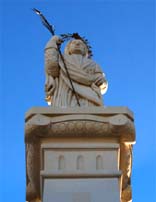 Martignano is the smallest town of Grecia Salentina. Anyway, even though there is not a large number of inhabitants, it is a town full of events, among which the most famous are “Carnival” and the festival in honour of the patron saint. Martignano is the smallest town of Grecia Salentina. Anyway, even though there is not a large number of inhabitants, it is a town full of events, among which the most famous are “Carnival” and the festival in honour of the patron saint.
The façade of the “Chiesa matrice” is not so elegant, but inside it keeps beautiful works of art. You will admire the artistic bell-tower built about in 1681 and the two lateral altars.
Other important monuments are: the Chapel of St. Giovanni (with a painting portraying St Giovanni in the act of giving baptism to Jesus), the convent of the Franciscans friars built in the early 1600, palazzo Palmieri (with a beautiful back garden which is now a public park and an oil mill), and the “pozzelle”which originally were used to get the rainwater used for the soil.
Like Calimera, Castrignano dei Greci too in the name recalls that 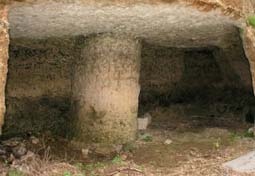 it is part of the Grecia Salentina. Between the 9th and 10th centuries the town was under the domination of the Greek Byzantine people who imposed their laws, their language and habits; in fact Castrignano kept the Byzantine rite until 1614. Still today people speak a kind of a Greek dialect and follow some ancient habits taken from Greek civilization. Anyway the origins of the town are uncertain though the legend says that it was founded by Minosse or by the Roman “Castrinus” and that it served to stop the invasionscoming from the sea and from the North. What we know for certain is that it was founded near a Roman campus (“castrum”, in fact). In the built-up area you will admire the byzantine it is part of the Grecia Salentina. Between the 9th and 10th centuries the town was under the domination of the Greek Byzantine people who imposed their laws, their language and habits; in fact Castrignano kept the Byzantine rite until 1614. Still today people speak a kind of a Greek dialect and follow some ancient habits taken from Greek civilization. Anyway the origins of the town are uncertain though the legend says that it was founded by Minosse or by the Roman “Castrinus” and that it served to stop the invasionscoming from the sea and from the North. What we know for certain is that it was founded near a Roman campus (“castrum”, in fact). In the built-up area you will admire the byzantine 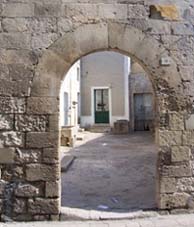 “Crypt of St. Onofrio” (6th century a. D.). It was built by the Basilian monks and they gave it such name because in the area there was a menhir upon which there was the statue of the saint. Inside the crypt there is also the Greek inscription “IBYZ” that means “1237”, probably the year when it was restored. “Crypt of St. Onofrio” (6th century a. D.). It was built by the Basilian monks and they gave it such name because in the area there was a menhir upon which there was the statue of the saint. Inside the crypt there is also the Greek inscription “IBYZ” that means “1237”, probably the year when it was restored.
The Castle, built in “pietra leccese”, was once surrounded by a deep moat. On the portal you will see the coat of arms of the Gualtieri family, its first owners. The façade on the South was restored in the early 1600 and has beautiful Baroque decorations, because that was the period of splendour of the Baroque style.
The parish church is the “Church of Annunziata”, built in 1878 where there are beautiful paintings. In “Parco Pozzelle” there are about a hundred wells very well preserved until today; they were used to receive the rainwater that was then used by the inhabitabts.
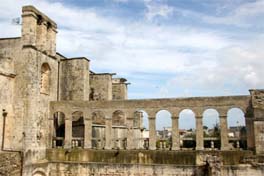 Melpignano is famous not only for the Convent, but also for the main square (St. Giorgio Square), that is unusual for Salento: in fact, it is formed by porticos with rounded barrel-vaulting. It was built like this because in the 16th century an important market took place here, with merchants from Lecce, Bari and Naples. Nearby there is the “Parco della Pace”, a real toyland for children in a beautiful garden full of swings, slides and others roundabouts. Opposite the square there is the beautiful “Church of St. Giorgio” (1500) where two famous singers, Nabil and Noa have recently received honorary citizenship to the sound of the miraculous music that cured the “tarantate”. In Melpignano you can also taste gastronomic specialities, especially “pizze” cooked in wood-burning ovens or ice creams. Melpignano is famous not only for the Convent, but also for the main square (St. Giorgio Square), that is unusual for Salento: in fact, it is formed by porticos with rounded barrel-vaulting. It was built like this because in the 16th century an important market took place here, with merchants from Lecce, Bari and Naples. Nearby there is the “Parco della Pace”, a real toyland for children in a beautiful garden full of swings, slides and others roundabouts. Opposite the square there is the beautiful “Church of St. Giorgio” (1500) where two famous singers, Nabil and Noa have recently received honorary citizenship to the sound of the miraculous music that cured the “tarantate”. In Melpignano you can also taste gastronomic specialities, especially “pizze” cooked in wood-burning ovens or ice creams.
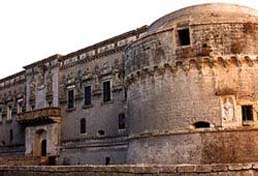 Corigliano d’Otranto is famous for its medieval Castle. From Piazza San Nicola, through Lucchetti Arch (1497), you go into the city centre. On the Arch symbols, metaphorical elements and figures are engraved, which seem to be the work of a great artist, not of a small stone-cutter of “pietra leccese”. In the square you will admire also the “Clock tower” and the beautiful front of “Palazzo Comi”, with its little cherub who holds a fake double lancet window. In the “Curch of St. Nicola” (1622) there is a mosaic of the Tree of Life that recalls the one inside the Cathedral of Otranto. Next to it the Bell Tower, very similar to the one in Soleto. Corigliano d’Otranto is famous for its medieval Castle. From Piazza San Nicola, through Lucchetti Arch (1497), you go into the city centre. On the Arch symbols, metaphorical elements and figures are engraved, which seem to be the work of a great artist, not of a small stone-cutter of “pietra leccese”. In the square you will admire also the “Clock tower” and the beautiful front of “Palazzo Comi”, with its little cherub who holds a fake double lancet window. In the “Curch of St. Nicola” (1622) there is a mosaic of the Tree of Life that recalls the one inside the Cathedral of Otranto. Next to it the Bell Tower, very similar to the one in Soleto.
|